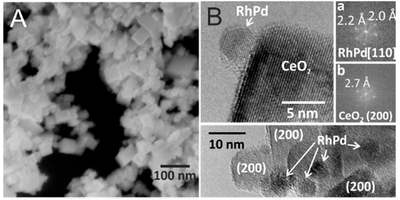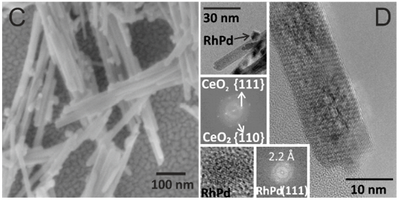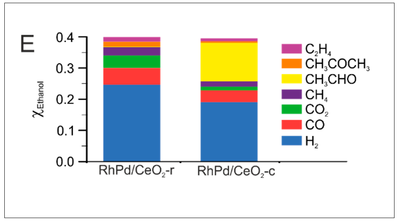

Scanning electron microscopy images of nanoshaped ceria supports: nanocubes (A) and nanorods (C). Complementary images B and D show rhodium and palladium metal nanoparticles fixed at these supports.
Cerdanyola del Vallès, 11th December 2019 Hidrogen is being contemplated as a product that could replace fossil fuels before they are depleted and allow the current energy model to be changed in favour of a more sustainable and environmentally friendly one. Out of various liquid hydrogen sources, ethanol is a sustainable candidate because of its renewable nature, increasing availability, biodegradable nature, low toxicity, and ease of transport. It can be converted to hydrogen through the catalytic steam reforming process.
A research group from the Institute of Energy Technologies (INTE) and the Department of Chemical Engineering — both of which belong to the Universitat Politècnica de Catalunya — is working on catalysts to get more effective hydrogen production reactions.
The studied catalysts contained metal – rhodium (Rh) and palladium (Pd) – nanoparticles of 4 nm in size fixed to a ceria support (CeO2). Scientists wanted to analyse the changes in the nanoparticles atomic distribution depending on the support nanoshape. To do so, they have compared two types of nanoshaped ceria, nanocubes and nanorods, and loaded them with model Rh0.5Pd0.5 nanoparticles.
AP-XPS experiments have been carried out at the NAPP endstation of CIRCE beamline, where they have monitored the surface composition and oxidation states of Rh0.5Pd0.5 nanoparticles supported over CeO2 nanocubes and CeO2 nanorods during the catalytic steam reforming of ethanol (ESR).
Significant differences in the distribution of the reaction products are evidenced when comparing both kinds of catalysts. In the case of the ones supported over ceria nanocubes, the dehydrogenation of ethanol into acetaldehyde and hydrogen is the main reaction observed (1), with a minor contribution by the decomposition of ethanol into methane, carbon monoxide and hydrogen (2).
1) CH3CH2OH → CH3CHO + H2
2) CH3CH2OH → CH4 + CO + H2
In contrast, when nanoparticles are supported over nanorods there is a marked increase of hydrogen production. The almost absence of acetaldehyde in the reaction products indicate that nanorods support strongly promotes reactions 3 and 4, yielding a much more efficient ESR catalyst.
3) CO + H2O → CO2 + H2
4) CH4 + 2H2O → CO + H
Researchers conclude that the crystal planes exposed by ceria have a strong influence both on the surface reorganization and oxidation states of Rh−Pd bimetallic nanoparticles, which in turn strongly determine the catalytic behavior in the ethanol steam reforming reaction.
This work provides original information about the importance of nanoshaped supports on the dynamics of bimetallic particles under reaction and represents a step forward in the understanding of multimetallic catalytic systems, widely employed in several industrial and environmental applications. The effect of the ceria nanoshape on the characteristics of bimetallic metal nanoparticles represents a new and important element to take into consideration in catalyst design.

Ethanol conversion (χ Ethanol) and product selectivity obtained depending on the nanoshaped supports, nanorods (left) and nanocubes (right), for ESR at 823 K.
Reference: Lluís Soler, Albert Casanovas, James Ryan, Inmaculada Angurell, Carlos Escudero, Virginia Perez-Dieste, Jordi Llorca. Dynamic reorganization of bimetallic nanoparticles under reaction depending on the support nanoshape: The case of RhPd over ceria nanocubes and nanorods under ethanol steam reforming. ACS Catalysis (2019) 9, 4, 3641-3647 DOI: 10.1021/acscatal.9b00463




